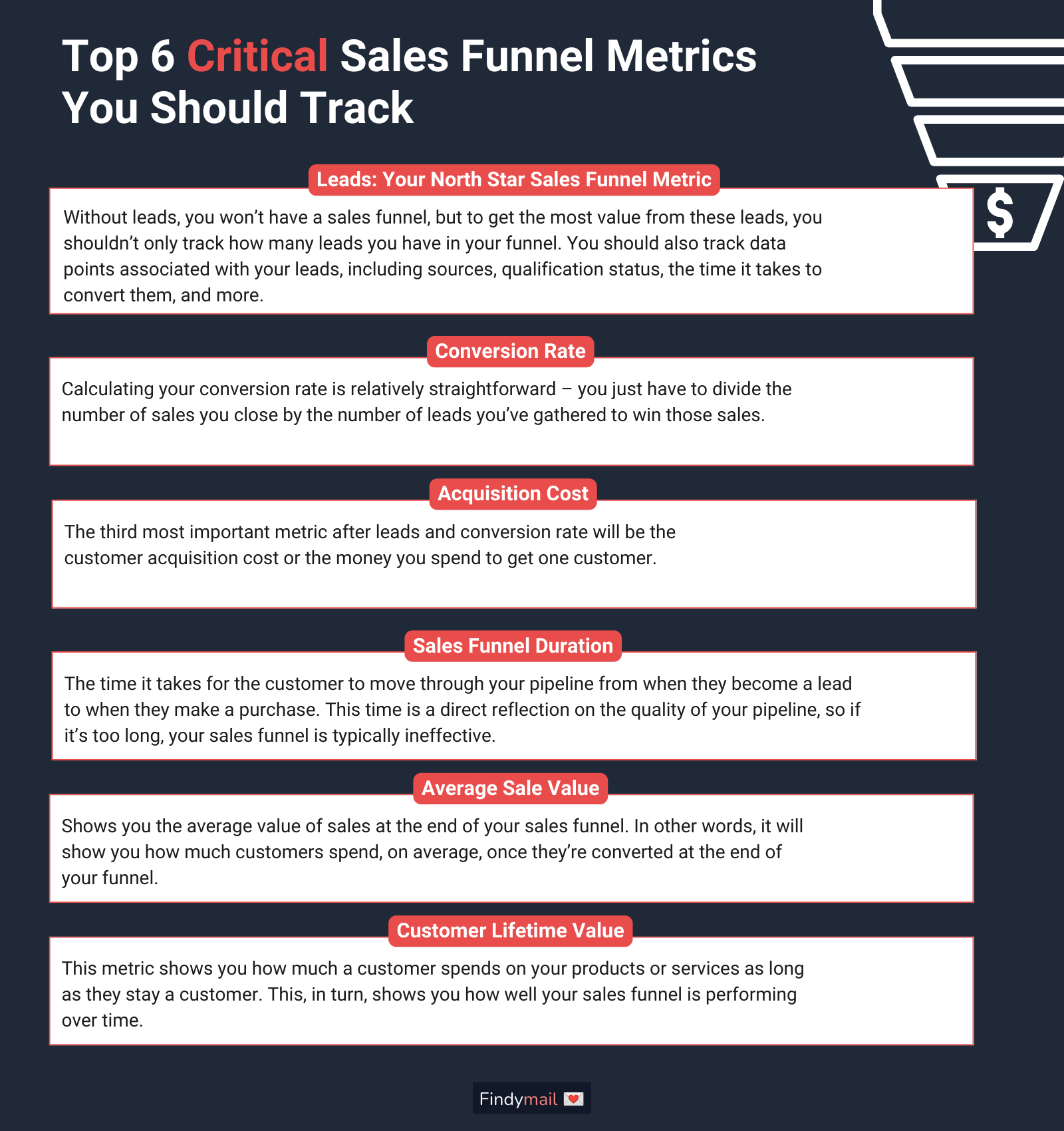In an extremely competitive market, you want your sales and marketing processes to be as effective and efficient as possible. Unfortunately, if you don’t know where to look, it’ll be hard to spot problems before they cause leaks in your funnel.
So today, I’ll walk you through the top 6 sales funnel metrics you should keep an eye on.

Let’s dive in!
Why Are Sales Funnel Metrics Important?
If you don’t measure something, you can’t improve it. And this is where these metrics come in: they provide you with the data points that give you deeper insights into your sales and marketing processes.
With these insights, you’ll learn which strategies and tactics are paying off and which aren’t. Based on this, you can make improvements and fix issues before they can affect your bottom line.
Critical Sales Funnel Metrics You Should Measure and Track
Now that we’ve recapped why sales funnel metrics are important let’s look at some of the most important metrics you can track.
1. Leads: Your North Star Sales Funnel Metric
Without leads, you won’t have a sales funnel, but to get the most value from these leads, you shouldn’t only track how many leads you have in your funnel. You should also track data points associated with your leads, including sources, qualification status, the time it takes to convert them, and more. When you do, you’ll learn a lot more about the health of your funnel.
For example, when you track how many qualified leads are in your funnel, you’ll know how many are likely to convert. Likewise, when this number is low, it’s a perfect indication that you should spend more time on qualifying your leads.
When analyzing your lead data, it’s also important to consider your lead sources. For example, does your email finder find enough emails? This, in turn, will show you how effective your different marketing efforts are at attracting more leads into the funnel.
2. Conversion Rate
Apart from leads, your conversion rate is another critical sales funnel metric to track. Fortunately, calculating your conversion rate is relatively straightforward – you just have to divide the number of sales you close by the number of leads you’ve gathered to win those sales. Since you want as many leads as possible to convert into paying customers, you’ll want your conversion rate to be as high as possible.
Conversely, just like a high conversion rate is a precursor to more sales and more revenue, a low conversion rate could signal significant issues in your sales funnel.
For example, it could be that your nurturing efforts fall short, which, in turn, could mean more training for your sales team. And speaking of your sales team, when applied to your sales reps individually, the conversion rate will show you who is on par and who is lagging behind.
From here, you can take corrective action to ensure your team performs at its best.
3. Acquisition Cost Is a Key Sales Funnel Metric
If you consider the most important sales funnel metrics to be a trinity, then the third most important metric after leads and conversion rate will be the customer acquisition cost or the money you spend to get one customer.
You can have as many leads as you’d like and an extremely high conversion rate, but if you spend more money to acquire them than the revenue they bring, they won’t amount to much. In other words, to ensure that you generate consistent profits, you’ll want to optimize your acquisition cost, so it covers your expenses and leaves you with a neat margin.
If your acquisition cost is too high, it typically shows that you’re spending too much on marketing and nurturing campaigns that are not effective. To solve this problem, you should track these processes carefully to get granular insights into them. These insights will show you what’s working, what’s not, and where you should improve.
For example, you may need to improve your lead list building if you deal with a lot of unqualified leads, or your Account Executives may need more training if they let good opportunities slip through the cracks.
4. Sales Funnel Duration
Another important metric to measure and track is your sales funnel’s duration. This is the time it takes for the customer to move through your pipeline from when they become a lead to when they make a purchase.
This time is a direct reflection on the quality of your pipeline, so if it’s too long, your sales funnel is typically ineffective and low-quality.
To improve this metric, you’ll need to measure the cycle time. This is the time it takes for a lead to move from one step to the next in your sales cycle.
When tracking this metric, you’ll be able to identify where the issues in your funnel are and what you can do to eliminate them. For example, you could realize that you need to implement new strategies to improve email deliverability or use new sales or cold outreach tools to speed up the process and make it more efficient.
5. Average Sale Value: How Much Money Is Your Sales Funnel Making You?
As the name implies, this metric shows you the average value of sales at the end of your sales funnel. In other words, it will show you how much customers spend, on average, once they’re converted at the end of your funnel.
To generate consistent profit, you’ll want to keep this value high while your acquisition costs stay low.
If this value, however, is too low, there are a few things you should consider. For example, when this value is too low, it shows that you might be targeting the wrong customers. To fix it, you’ll then need to do proper market research to find the right target customers.
You might also look at new methods for sourcing leads, from smarketing to asking for sales referrals.
6. Customer Lifetime Value
Finally, you should also track your customer lifetime value or LTV. This metric shows you how much a customer spends on your products or services as long as they stay a customer. This, in turn, shows you how well your sales funnel is performing over time.
It goes further than this, though. When you know the customer lifetime value of a customer, you’ll know what your acquisition cost should be to turn a profit.
When this metric is too low, it typically signals severe problems with your after-sales or customer service processes. Fortunately, you can sort these issues out when you consider and implement customer feedback.
Track the Right Metrics Now!
If you don’t know where you’re going, any road will take you there. As you boost your sales processes, don’t forget to track them, so you know what works (and what doesn’t). It’s the best way to ensure your sales machine is humming!






